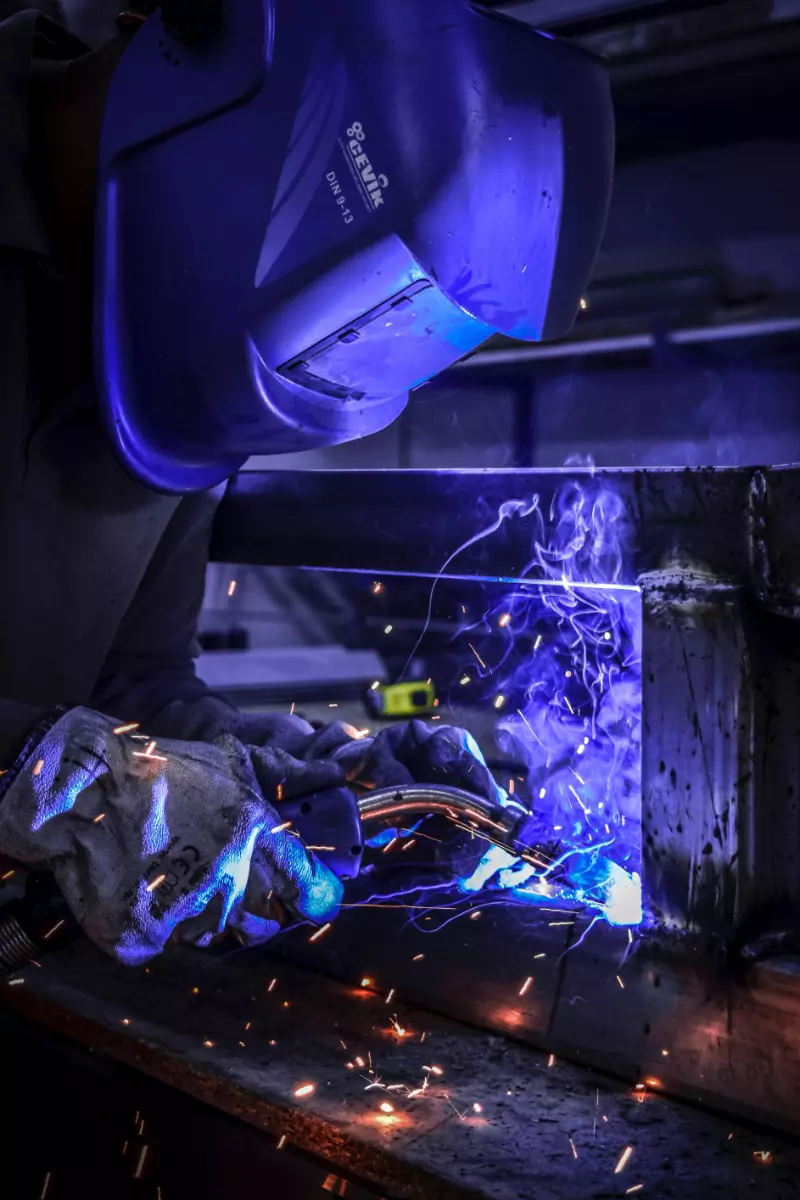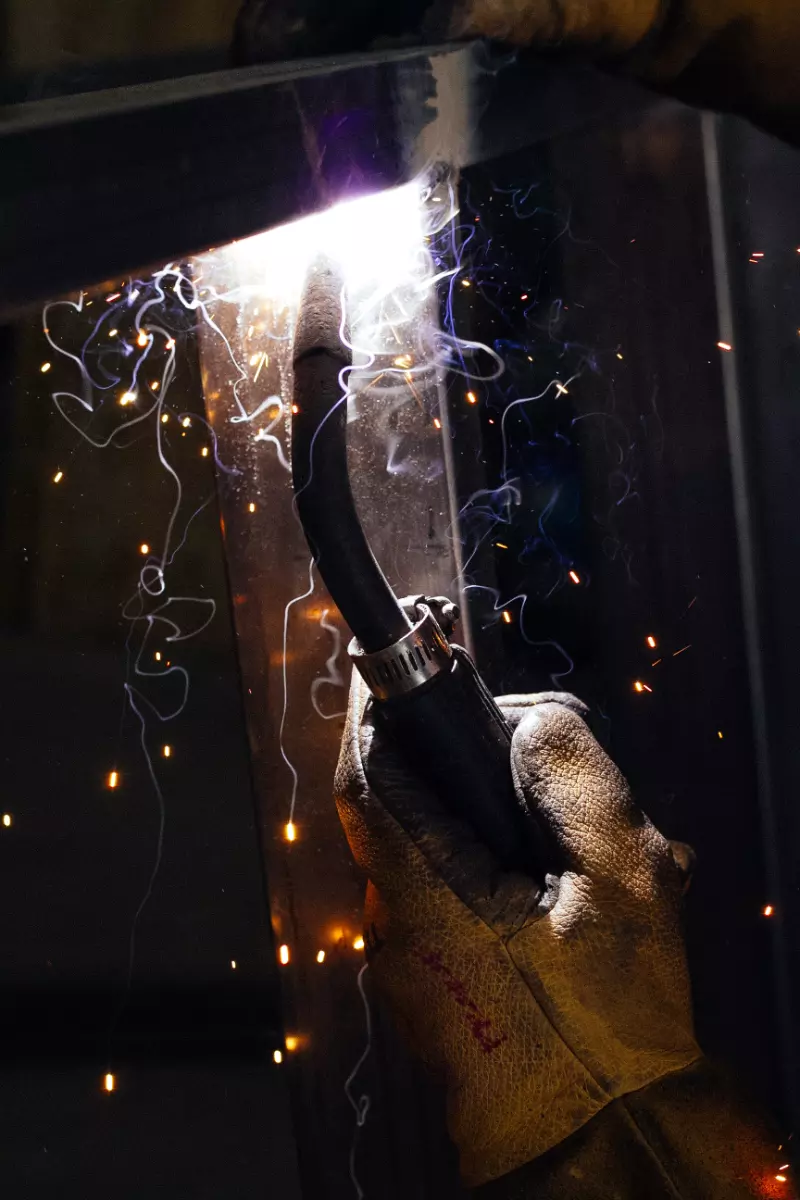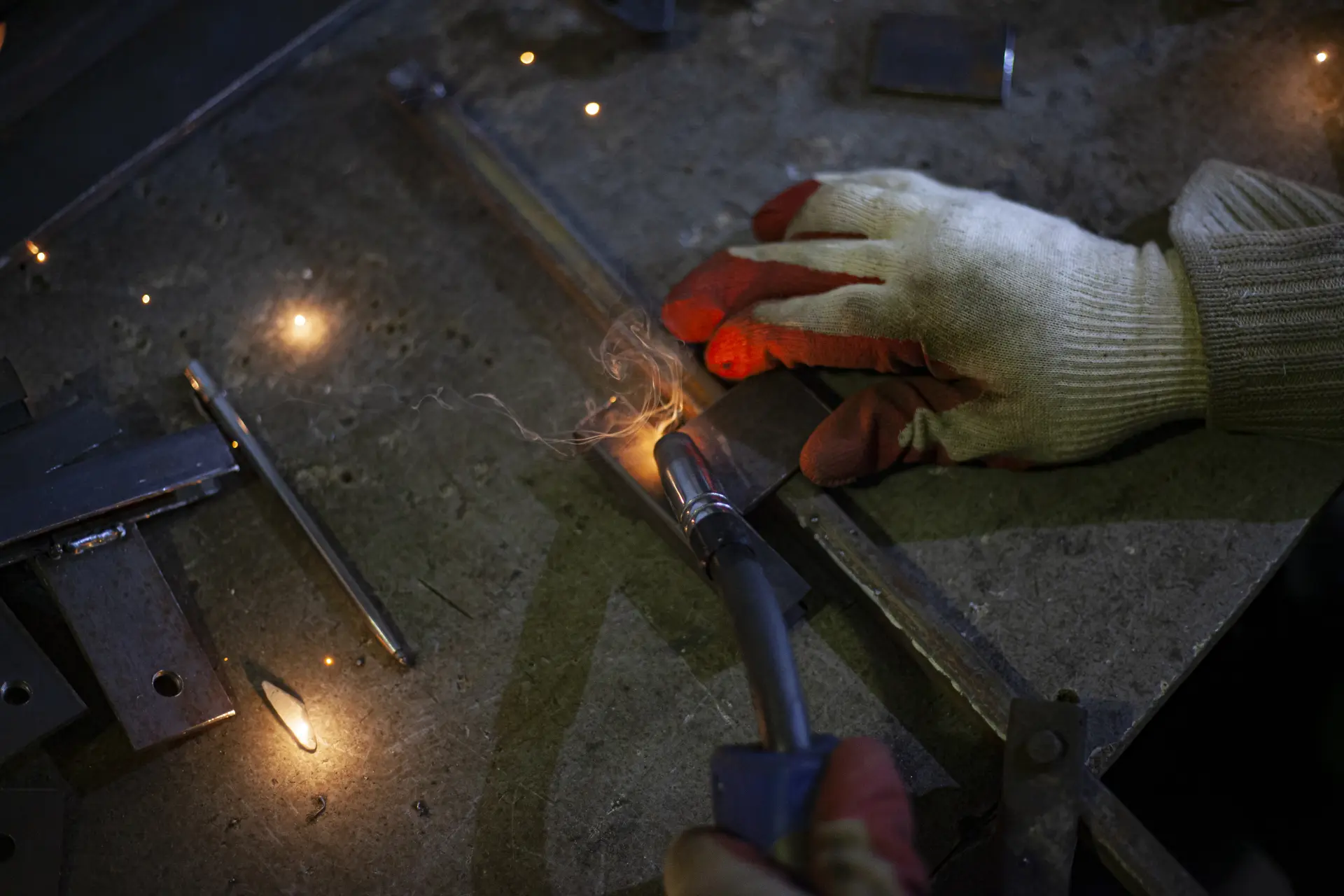This page looks at how TIG welding works, what the TIG process involves in practical terms, how it compares with MIG and stick welding, and why it is preferred when the highest quality results are required.
Tungsten Inert Gas welding, often called TIG welding and formally known as Gas Tungsten Arc Welding (GTAW), is a welding process that uses a non consumable tungsten electrode to create an electric arc with the workpiece.
Developed in the 1940s, GTAW transformed fabrication of aluminium and magnesium, offering exceptionally clean welds with precise heat control. Instead of slag, a shielding gas, usually argon, sometimes helium or blends, protects the weld pool from atmospheric contamination so the welds remain bright and sound.
Unlike processes that continuously feed filler through the welding torch, TIG separates the torch from the filler rod. The tungsten electrode carries current to create the arc that melts the base metal; if extra metal is needed, a matching filler material is hand-fed into the weld puddle.
This separation gives the welder fine control over arc length, travel speed, and heat input, which is why TIG is preferred for thin sections, intricate pieces and critical materials such as stainless steel, titanium, copper, and nickel alloys.
TIG welding process
With TIG, the arc is struck between the pointed tungsten tip and the prepared workpiece. The weld area is flooded with inert gas flow from the TIG torch, excluding oxygen and nitrogen that would otherwise cause porosity and embrittlement. Because the tungsten is non-consumable, it does not deposit metal into the joint; any reinforcement is added by dipping a compatible filler wire at the leading edge of the weld pool.
The welder modulates welding current, often by a foot pedal, to keep penetration and bead shape steady as joint thickness and heat sinking vary along the seam.
Cleanliness is critical. Oxides, rust, paints and oils must be removed so the arc can be maintained and the puddle can wet the material edges evenly. Proper joint design and consistent fit-up help the puddle flow, reduce distortion and make it easier to achieve uniform penetration without excessive reinforcement.
Power Source, Polarity and Cleaning Action
A modern TIG power source is a constant-current machine capable of both AC DC output. On direct current (DC) with electrode negative (DCEN), roughly two-thirds of the arc heat is concentrated on the work, giving deep penetration and a narrow weld bead. DCEN is commonly used for steels, stainless steel, copper and many nickel alloys.
Alternating current (AC) is the go-to for aluminium and magnesium. AC alternates positive and negative half-cycles; during the electrode-positive portion, the arc provides a “cleaning action” that breaks up the tenacious oxide film so the puddle can form and flow.
Inverters let you adjust AC balance and frequency to fine-tune this effect, improving edge definition on thin materials while preserving penetration on thicker materials. DC with electrode positive is rarely used because it overheats the tungsten, but it illustrates how polarity changes the way the arc works.
Starting and Stabilising the Arc
Arc starting can be done by high-frequency ignition that ionises the gap without contacting the workpiece, preventing tungsten inclusions.
Many TIG welders also offer a controlled “lift-arc” start where a very low current flows as the tip touches and lifts from the surface.
On AC, high-frequency stabilisation helps re-ignite the welding arc at each polarity reversal so the arc remains steady and the puddle stays fluid.

Tungsten Electrodes and Tip Geometry
Choosing the right tungsten electrodes matters. Pure tungsten was traditional for AC, but modern doped grades; thoriated, ceriated, and lanthanated, improve ignition, reduce erosion and allow lower voltage drop.
Tungsten with zirconia performs well for AC when you want a stable balled tip. Diameter and tip angle should match the welding current: smaller electrodes and sharper points for lower currents and fine work, larger electrodes and blunter angles for higher currents and broader welds. Keeping the tip clean and properly shaped helps concentrate the arc and improve quality.
Shielding Gas Selection and Gas Flow
Straight argon is the most commonly used shielding gas because it starts easily and gives smooth arc characteristics on a wide range of materials. Helium or argon-helium mixes raise arc temperature for greater penetration and faster travel on highly conductive metals like copper or on thick sections, although the mix is more expensive and starts can be more difficult.
Small additions of hydrogen to argon can brighten surface appearance on austenitic stainless, but they must be used with care to avoid porosity or cracking in sensitive alloys. Correct gas flow, neither starving the puddle nor causing turbulence, is essential to protect the weld area; cup size, gas lens selection and torch angle all influence shielding effectiveness.
Filler Metal, Joint Prep and Heat Control
Selecting a compatible filler metal ensures the finished weld matches the base material in strength and corrosion resistance. For stainless steel, balanced chromium and nickel content preserves corrosion performance; for aluminium, matching series and the right magnesium or silicon content help avoid hot cracking.
Joint faces should be bright and clean, edges uniformly set, and mill scale or oxides removed immediately before welding.
Controlling heat input with the foot pedal, managing arc length, and pacing travel speed keeps the weld puddle the right size, limits grain growth, and reduces distortion so the finished form looks professional.
TIG Torch, Cooling and Ergonomics
The TIG torch is a precise, hand held tool. Air-cooled torches are light and convenient for moderate currents, while water-cooled designs remove more heat so you can weld longer at higher currents without discomfort.
Collet bodies or gas lenses maintain shielding and hold the tungsten electrode steady. A well-balanced torch, flexible leads and an organised bench make it easy to keep a steady hand, which directly improves bead appearance and fusion at the toes.
Where TIG Shines—and Where It Doesn’t
TIG is often considered the highest quality arc process when appearance and control matter. It produces virtually no spatter, gives excellent puddle visibility, and allows you to tie in delicate pieces of metal with minimal clean-up.
It excels on thin materials, dissimilar joints, root passes on critical pipework, and reactive metals like titanium where a pristine atmosphere is mandatory. In terms of advantages of TIG welding, think precision, cleanliness and versatility across many different alloys.
There are disadvantages of TIG welding to weigh. It can be expensive to set up with quality torches, gas systems and a good welding machine. Deposition rates are lower than MIG welding or stick welding, so it takes more time to fill large joints.
The skill requirement is higher because you coordinate torch, filler rods and amperage simultaneously. For heavy sections and production fillets, other welding processes may be more efficient.

Applications and Industries
You will find TIG in aerospace, food and beverage, pharmaceutical, motorsport, instrumentation and any environment where smooth, crevice-free weld beads and reliable metallurgy are required.
TIG welder operators use orbital heads for sanitary tube, manual torches for chassis work, and automated stations for repeatable seams. From artistic sculptures in stainless steel to pressure-retaining vessels in nickel alloys, TIG offers the benefits of accurate puddle control and tailored welding techniques for each joint.
What Is Better, MIG or TIG Welding?
Both MIG welding and TIG are fusion welding processes that melt the joint with electricity and can add filler material to create a bond. MIG is faster and more forgiving to learn because the wire is continuously fed through the torch, which suits repetitive production, thicker sections and out-of-position work.
TIG separates the filler from the torch, so the welder controls heat input and bead shape independently; this makes it ideal for intricate work, thin wall tubing and exacting finishes. The “better” choice is the one suitable for the job: MIG to move metal quickly with consistent penetration, TIG to achieve precise, cosmetic, high-integrity results.
Does TIG Welding Require Gas?
Yes. TIG cannot function without shielded atmosphere. The inert gas guards the tungsten electrode and the weld pool from oxygen and nitrogen while also cooling many torches.
Pure argon is the default; helium mixes and specialised blends are supplied for specific operation needs, but they raise costs and may vary starting characteristics.
Is TIG Welding Stronger Than Stick Welding?
TIG, stick welding and MIG all produce fusion bonds whose ultimate strength depends on base metal, filler wire selection and welding quality.
When procedure and materials are equivalent, the tensile properties of a TIG joint can match those made by stick or MIG on the same material.
Defects such as lack of fusion, inclusions or porosity will reduce strength regardless of type of process, which is why consistent technique and sound parameters are so important.

Common TIG Variables That Influence Quality
Small adjustments have large effects in GTAW. Shorter arc length concentrates heat and narrows the bead; longer arcs spread heat and raise voltage, risking oxidation. Faster travel speed limits heat tint on stainless steel but may undercut toes if pushed too far.
Using the right cup size and steady gas flow prevents turbulence. For aluminium, setting the proper AC balance maximises cleaning action without eroding the tungsten. For titanium and certain nickel alloys, trailing shields and back-purging are considered essential to protect hot metal until temperatures cool below oxidation thresholds.
Getting Started and Improving Technique
New welders often find TIG difficult because both hands are active and the puddle is small. Practising torch angle, consistent filler additions and coordinated amperage control helps the motion become easy and repeatable.
Keep coupons meticulously clean, clamp joints so they don’t wander as they melt, and select parameters that match joint thickness. With care and patience, TIG produces high quality seams that stand up to inspection for years.
Are you looking for welding equipment suppliers in Coventry and Warwickshire. Contact our welding equipment specialists working across Coventry, Rugby, Oxford and the surrounding areas.

